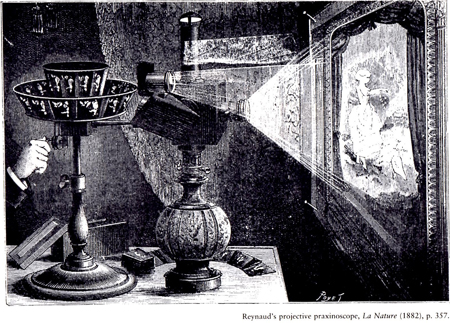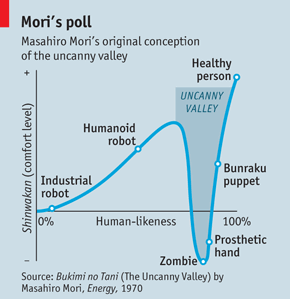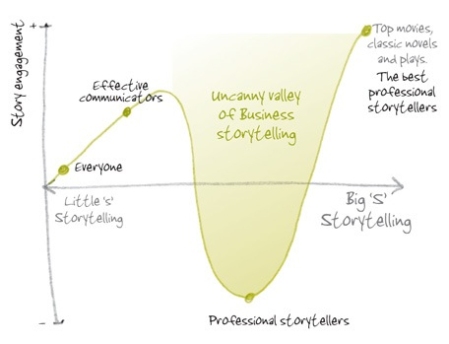
Back in 2006 Hugh Macleod offered the following point on Gapingvoid: “If people like buying your product, it’s because its story helps fill in the narrative gaps in their own lives.” At the time I thought it conveyed nicely the point made by Gerald Zaltman in How Customers Think that “companies should define customer segments on the basis of similarities in their reasoning or thinking processes” (p. 152) rather than constructs related to demographics. Hugh’s point made a lot of sense when I first read it and the point continues to gain in significance for me.
Hugh’s initial post sparked a range of interesting comments that I encourage anyone puzzled by the quote to read. The one point I’ll make about the topic is that nowhere in the post or the comments does anyone say what they mean by narrative gaps. I’ll attempt to clarify the concept below because it doesn’t simply mean stories. Stories that fill narrative gaps do so by purposively or accidentally creating personal curiosity, imagination, intrigue, or mystery for people experiencing them.
Narrative gaps in our personal stories are resolved through other stories about our own experience, perhaps with a product or service, that help us make sense of the feelings evoked. Specifically, Hugh noted in a later post that people fill in narrative gaps with meanings they construct from their own stories. It is on this point that the concept of personas becomes relevant to narrative gaps and to a recent conception of how to use social media robots, especially DigiViduals™, in qualitative research. Moreover, in this respect I suggest that the challenges involved are analogous to key ones faced by industrial robotics.
Social Media Robots and We-Research Strategy
I attended a webinar a few months ago offered by John Kearon from Brainjuicer called DigiViduals™: Generating Insights with Research Robots. Will Goodhand of Brainjuicer gives the concept a succinct definition as “robotic researchers programmed to represent a particular type of person.” The research strategy offers a way to add social color to trends or segments from qualitative data gathered by search robots as they traverse the web, especially social media. Social media robots use keywords describing feelings or sensibilities to select content from the web.
Several points John made led me to recall Hugh’s post about narrative gaps and marketing. John provided an overview of the research concept of DigiViduals™. Brainjuicer’s DigiViduals™ research strategy is one instance of a transformation in the opportunities available for crowdsourcing qualitative data. However, John noted in his webinar that their DigiViduals™ search robot does not weave together a narrative to make sense of the data it collects. The analysis of such qualitative data remains an area for research strategists and analysts. The point is important and relates directly to the usefulness of narrative gaps in relaying research insights to an audience, whether clients or peers.
I’ve been using Philter Phactory’s beta application, the Weavrs platform, to generate Benson over the past couple of months so you can check out what the raw narrative looks like from that Weavr. You can tell by reading Benson’s description of his activities that the gaps in the narrative he weaves are really more discontinuous anecdotes that are not evocative by any means. He is not a persona that most people will find real and, I would argue, social media robots won’t really become that sophisticated because they can’t use narrative gaps on purpose, or even convincingly by accident.
The Philter Phactory characterizes Weavrs as alter egos for the social web. Benson introduces himself as follows:
I’m a male Weavr, born in 1970 and I live in 2548 Scenic Dr, Austin, TX 78703, USA. I am from the Philter Phactory. I’m completely free of any artificial intelligence but do what I can to be social and emerge as an interesting character.
Benson’s narrative is constructed around feelings described by the following human characteristics: appreciation, upbeat, trustworthy, outgoing, hesitant, and aware. Robot narratives such as the one in Benson’s blog provide a range of interpretive resources to use in developing personas in market or design research.
Benson does not yet have a feeling about specific brands but given the way Weavrs work it would be easy to do. However, it is up to the researcher rather than the robot to weave a story together from the anecdotal observations to produce a sense of Benson’s everyday life. I haven’t yet taken this design step but plan to shortly.
You might find interesting David Bausola’s presentation overview of the Demo Graphic Replicator, another variation on social media robots that uses the We Feel Fine application programming interface.
The digividuals, weavrs and other social media robot applications provide an interesting way to search, find, and pull together social media on how people think and feel about what they do as they go about their daily life. The general approach promises a variation on persona development to exemplify a market segment potentially useful in generating consumer insights around product/service development. As that last comment implies, I think personas are important to marketing and design, especially those based in observations of actual human thought and action.
However, one part of the social media research robot technology and the associated research concepts bothers me. The research strategy depends specifically on a key assumption made by what Brainjuicer labels we-research. The we-research approach assumes that people are better observers of other people than they are of themselves, a position that many in the market research industry seem to accept. If that is the case, it certainly won’t hurt to remind all who embrace we-research that longstanding findings in social psychology point to the unreliability of eye-witnesses to events.
People are at least as much participants as they are observers though I would argue they are more the former than the latter as they go about their lives. Among the most important things to notice about we-research, but especially the digividual concept, is its goal of enabling mass ethnography. Brainjuicer offered a precursor of the concept with its attempt to crowdsource ethnography a couple of years ago. The findings from that experiment emphasized the importance of making professional examples available to participants doing the observational work of the research so that they model the skills and creativity required by an ethnographic collaboration.
In other words, just turning a group of consumers loose with smartphones to record their experiences didn’t result in much useful information unless researchers provided some structure and examples of how to do the observation. That doesn’t mean I question the usefulness of smartphone applications such as Ethos (by EverydayLives) or Revelation Mobile (by Revelation) in doing qualitative research, including ethnography. However, I do question the ability of crowdsourced qualitative data alone to answer ethnographic questions.
Digividuals are another variation on the crowdsourcing strategy, though one that explicitly recognizes the importance of using the data gathered to construct “life-boards” and “day-in-the-life-videos” in order to communicate insights about brands or products. Josh Kamowitz offers an informative overview of the Brainjuicer approach.
Rather than co-create the digividual with research participants producing qualitative data, whether ethnographic or otherwise, Brainjuicer’s DigiViduals™ approach uses search robots to gather qualitative data by identifying observable patterns of action across the daily lives exemplified in the social media creations of other individuals. Those using the approach then create a narrative to weave stories through those patterned observations. However, just as ethnographers don’t stop at observing but also listen, probe and explore the meanings involved in how people act, or fail to act, the narrative developed from social media robots is most persuasive when it also includes gaps, missing actions. Perhaps analyzing one of the digividuals resulting from Brainjuicer’s DigiViduals™ search technology can clarify why narrative gaps are important to the approach even though I haven’t seen them mentioned by any discussions by Brainjuicer.
Thinking About Narrative Gaps in the DigiVidual — Nicole
The techniques displayed in the DigiVidual, Nicole, are rich in media narrative. Take a few minutes and watch the day-in-the-life video offered by Brainjuicer about Nicole. Nicole starts her day at a local coffee shop that makes artistic lattes, then goes to work as a jewelry designer. While at work she takes a break to buy a love gift for her hubby, in this instance it is sweets.
After work Nicole meets a few friends at a local pub where they drink wine and talk about books. After a while she goes home and sees Toto her puppy, then she goes to bed. Hubby is nowhere in the narrative when Nicole gets home. Where is hubby? However, even without knowing where hubby is when Nicole gets home and why he isn’t going to bed with her, the narrative of the Nicole persona still seems real. Why is that the case? I’d suggest that whether intentional or an oversight, the Brainjuicer team left a narrative gap in the story.
Even though we know Nicole bought some sweets for her hubby and never gave them to him, the feeling she has for him is conveyed to the audience which in this case was a Brainjuicer client. Perhaps the Brainjuicer researchers implicitly realized the insight offered recently by Anecdote about the relationship between stories and realism in the context of robotics research.
Shawn Callahan recalls research done on robotics in the 1980s by Mashahiro Mori who noted that as robots were made more humanlike their attractiveness to people decreased and only began increasing as they were made indistinguishable from humans. Shawn then proceeds to consider whether the lessons learned in robotics apply to how people tell stories. He offers a storytelling analog to Mori’s uncanny valley in robotics.

I suggest that social media robots face limitations in constructing personas analogous to those of industrial robots, though the former does not so far attempt to use artificial intelligence in weaving their stories. Effective communication in the use of social media robots for qualitative research is most likely to occur when the researcher designs narrative gaps into stories, such as “day-in-the-life-videos”, used to convey insights about the way consumers relate to brands and products. The challenge of creating such stories is, by nature, a human one.
Posted by Larry R. Irons
Share this post…












Social Media Toolbox…
[…]Social Media Robots, Personas, and Narrative Gaps in Qualitative Research « Skilful Minds[…]…
Good day! This is my first visit to your blog! We are a team of volunteers and starting a new initiative in a community in the same niche.
Your blog provided us useful information to work on.
You have done a wonderful job!